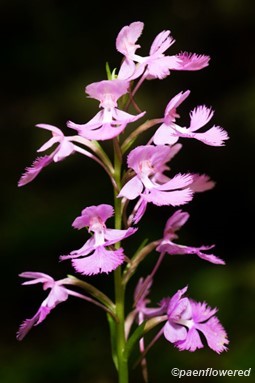Platanthera grandiflora
Platanthera grandiflora greater purple fringed orchid
The purple to (rarely) white flowers of P. grandiflora are found in a fragrant, relatively loose raceme that can measure almost a foot high on large plants. Individual flowers have deeply fringed, almost “fan-shaped” lower petals and lateral sepals. Its flowers can be distinguished from the similar P. psycodes due to a more rounded opening to the nectary and rostrum lobes that are longer and spreading as opposed to perpendicular. This perennial member of the orchid family blooms from June to August across its range (most commonly reaching peak bloom in mid to late June in Pennsylvania) and is found in scattered populations across the state. P. psycodes generally blooms about one month later, although some populations in Northwestern Pennsylvania – for reasons still yet unknown – overlap with the bloom time of P. grandiflora. Where overlap does occur in geographically close populations, the two species are known to hybridize, which can lead to even greater confusion in the field.
The plant produces two to six often large alternating leaves up its stem. Height varies from around 10 inches to nearly 4 feet tall. P. grandiflora is most often found in wetlands, including bogs, wet woods, and swamps.
Its overall range in the U.S. is limited mostly to the Appalachian Mountains, from Maine to Georgia, although a disjunct population in Illinois has been documented. In Pennsylvania it is not listed as a plant of conservation concern but in most areas is not as common as P. psycodes, which at first glance looks very similar. Two other purple Platanthera orchids – P. peramoena and P. shriveri, also grow in Pennsylvania but are much rarer and limited in range.
Sources:
Platanthera grandiflora. North American Orchid Conservation Center. See Platanthera grandiflora
Arethusa. Platanthera grandiflora Versus Platanthera psycodes. iNaturalist.org. Published on October 26, 2018. Available at iNaturalist.
Habitat & Range
Grows in bogs, swamps, wetland margins, and occasionally in forests, meadows, and fields.
Present throughout the state, scattered populations.
Range: Throughout the Appalachian mountains
| EMP: | FACW |
|---|---|
| NCNE: | FACW |
Phenology
Flowers from June to August.
Plant Codes
S-rank: No rank
G-rank: G5 (Secure)













Comments
Have you spotted this plant in your area? We'd love to hear about your experience! Share your comments or questions about the plant below. Comments are moderated before posting.